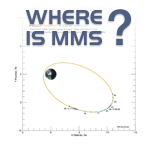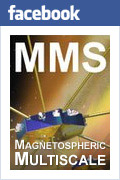LATEST MISSION NEWS | OLDER MISSION NEWS
MISSION NEWS LINKS
- Magnetospheric Multiscale Newsroom at NASA
- MMS News from the MagMultiScale Facebook Community
2016
07.26.16 : Geophysics Research Letters - Special Issue
- NASA First results from NASA's Magnetospheric Multiscale (MMS) Mission
The Magnetospheric Multiscale (MMS) mission has been performing particle and electromagnetic field measurements in the near-Earth environment since its launch in March 2015. Thanks to data with unprecedented time resolution on four identical spacecraft in a close tetrahedron configuration (down to 10 km), MMS science goals are to probe and understand the electron-scale physics involved in the magnetic reconnection process. This collection provides a selection of key results obtained during the first phase of the mission at the dayside magnetopause. It includes new observations of the geometry and variability of the reconnection process, the detailed dynamics of particles, fields and waves in the vicinity of the reconnection region, the observation of small-scale signatures at current sheets formed in the magnetosheath, in Kevlin-Helmholtz vortices, or flux transfer events, as well as other small-scale features which are by-products of magnetic reconnection or not. These results open a new window for our understanding of magnetic reconnection in space, with direct and numerous implications for astrophysical and laboratory plasmas.
05.12.16 : Mission Update
- NASA's MMS Captures Magnetic Reconnection in Action
The Atlas V rocket lifts off from Space Launch Complex 41 at Cape Canaveral Air Force Station carrying four Magnetospheric Multiscale, or MMS, spacecraft on a mission to study magnetic reconnection.
- NASA Directly Observes Fundamental Process of Nature for 1st Time
A new paper printed on May 12, 2016, in Science provides the first observations from inside a magnetic reconnection event. The research shows that magnetic reconnection is dominated by the physics of electrons - thus providing crucial information about what powers this fundamental process in nature. - NASA probe results could improve space weather forecasts [RICE NEWS]
MMS mission delivers promised measurements of 'magnetic reconnection'
2015
- The Way I See It : A long road to a perfect launch by Pat Reiff and Jade Boyd
MMS LAUNCH - March 12, 2015: NASA Spacecraft in Earth's Orbit, Preparing to Study Magnetic Reconnection
- Liftoff of MMS
The Atlas V rocket lifts off from Space Launch Complex 41 at Cape Canaveral Air Force Station carrying four Magnetospheric Multiscale, or MMS, spacecraft on a mission to study magnetic reconnection. - MMS Spacecraft Separation
The four Magnetospheric Multiscale, or MMS, spacecraft separate from the Centaur upper stage as they are deployed into orbit. (Live TLM Data animation) - MMS Spacecraft Separates from Centaur
A camera on the Centaur upper stage shows one of four Magnetospheric Multiscale, or MMS, spacecraft as it separates and is deployed into orbit. - MMS on the launch pad (ground observer)
- MMS launch on March 12, 2015 (ground observer)
- Mission Highlights - 06.11.15
- MMS is currently in the eclipse period at apogee that extends through June 21. Instrument commissioning activities, which have been largely stood-down during this period, will resume on June 22.
- Maneuvering of Observatory #3 to warm up the -Z ADP boom and perturb it with thruster firings was unsuccessful in fully extending the boom from 97% to 100%. However, it did demonstrate that the boom is structurally stable and can perform science measurements as planned. The team has no further actions planned and Observatory #3 has been returned to the proper attitude for science operations.
- A conjunction with the Van Allen Probes spacecraft occurs on June 12, which will provide an excellent cross calibration opportunity for MMS instruments. The team has noticed an increase in magnetic activity in the days leading up to this conjunction, so there are high hopes for interesting science as well.
- Mission Highlights - 05.15.15
- Commissioning activities continue to occur on schedule.
- With the successful deployment of the Energetic Ion Spectrometer doors on all four observatories, all MMS deployment activities are now complete.
- All observatories have been moved back to mission attitude after Axial Double Probe boom deployments.
- All instrument High Voltage activation operations have been concluded in preparation for the eclipse period, which extends May 12 through June 21.
- Navigator calibration efforts have now commenced.
- Mission Highlights - 05.04.15
- The -Z Axial Double Probe (ADP) boom on Observatory 3 experienced an anomaly during deployment and is believed to be 97% deployed. Initial data indicates there will be no impact to science in this current state.
- The +Z ADP boom on Observatory 3 deployed without issue and subsequent ADP boom deployments on other observatories are planned to resume no later than May 3.
- The MMS constellation's orbit, spin rates and attitudes are all nominal, as are all spacecraft systems and instruments.
- The Spin-plane Double Probe 60 meter wire boom deployments are complete on all observatories.
- All observatory spin rates have been reduced to the nominal 3 rpm in preparation for the ADP 12.5m boom deployments.
- Mission Highlights - 04.24.15
- MMS commissioning continues on schedule and with no significant issues.
- The Spin-plane Double Probe 60-meter wire boom deployments were completed on all Observatories on April 23. The MMS Fields (electric and magnetic field instruments) investigation is now fully operational in the spin-plane and all the data looks good.
- The Axial Double Probe 12.5 meter boom deployments are scheduled to begin the evening of April 26. These carry electric field instruments and will complete the 3-dimensional Fields investigation sensor deployments.
- The data downlink sequence issue has been resolved, with repeated error-free performance during Deep Space Network passes.
- Mission Highlights - 04.10.15
- MMS commissioning is on schedule.
- The MMS constellation's orbit, spin rates and attitudes are nominal.
- Spin rates are 6.9-7.3 rpm as a result of planned spin-up to deploy the Spin plane Double Probes (SDP) Thin-Wire sensors. All spacecraft subsystems are performing well with no problems.
- Closed loop maneuvers performance continues to be accurate.
- Power and Thermal systems are performing very well.
- Spin plane Double Probes Booms deployed to 17 meters (of 60 meters) on six SDPs and 22 meters on two SDPs, as planned.
- All instrument low voltage turn-ons were successfully completed.
- 2 of the 8 Active Spacecraft Potential Control Device (ASPOC) instruments are now in high voltage/emitting mode.
- Fast Plasma Investigation (FPI) high voltage activation begins today.
- Mission Highlights - 04.07.15
- The MMS constellation's orbit, spin rates and attitudes are all nominal.
- All spacecraft subsystems continue to perform well.
- Final perigee raising maneuvers have been completed.
- Low voltage checkout has been completed on all MMS instruments.
- High Voltage activation of Fields Electron Drift Instruments is nearing completion.
- Instrument activation is proceeding as planned.
- Spin plane Double Probe wire boom deployments began April 4.
- Mission Highlights - 03.27.15
- The MMS constellation's orbit, spin rates and attitudes remain nominal.
- All spacecraft subsystems are performing well with no issues.
- MMS successfully utilized a USN ground network station on 3/26/2015 for the first time.
- Scientists and engineers are proceeding as planned, turning on instruments aboard the four MMS observatories.
- The Spin plane Double Probe wire boom deployments are schedule to begin on April 4.
- Mission Highlights - 03.24.15
- FPI IDPU's and dual spectrometers' low voltage power on successfully on all four Observatories.
- The MMS constellation's orbit, spin rates and attitudes are all nominal.
- All spacecraft subsystems are performing nominally with no problems reported.
- Perigee raising maneuvers are going as planned.
- Activation of the Fields Suite and FEEPS continues with no significant issues.
- EIS powered on successfully on Observatories 2, 3 and 4.
- Mission Highlights - 03.19.15
- The MMS constellation's orbit, spin rates and attitudes are nominal.
- All spacecraft subsystems continue to perform as intended and the Navigator GPS performance is nominal.
- Observatory attitude control and maneuver performance are nominal.
- No significant issues with the Instrument Suite. Fields suite activations continue.
- All MMS observatories have been spun back up to 3 revolutions/minute after completing mag boom deployments. The Spin-plane Double Probe and Axial Double Probe booms are still stowed.
- The Electron Drift Instrument was activated and the Gun Detector Unit turned on with low voltage on all observatories. EDI flight software and data table loads have commenced on all observatories.
- Mission Highlights - 03.18.15
- The MMS constellation's orbit, spin rates and attitudes are all nominal.
- All observatory subsystems and instruments are performing well with no problems.
- The Fields suite has been powered up (on all four observatories) and instrument activation continues with no issues.
- All Axial Double Probe Boom Receiving Elements have been deployed.
- All 8 Magnetometer Booms (two per observatory) have been deployed.
- Mission Highlights - February 19, 2015:
- MMS Observatories #1 and #2 were mated to the Atlas Payload Adapter (PLA), and Observatories #3 and #4 were stacked on top for the final time prior to launch.
- Final separation system and pyro installation was completed.
- Final closeouts, cleaning and red tag/green tag activities are underway, with all cover removal planned to be completed by Sunday.
- Mission Highlights - February 5, 2015:
- All pre-stacking MMS Observatory thermal blanket close-outs were completed as planned.
- Pyros were installed in the Separation System Clamp-band systems on Mini-Stack #1 and Mini-Stack #2.
- The MMS Safety and Mission Assurance Review was (SMSR) conducted successfully this week.
- Mission Highlights - January 29, 2015:
- Observatories #3 and #4 completed fueling and pressurization today in another very smooth performance by the MMS Propulsion team.
- In the encapsulation bay adjacent to MMS at Astrotech ULA mated the Payload Adapter (PLA) to the Spacecraft Transportation Vehicle (STV). The MMS fairing is also at Astrotech and being prepared for encapsulation of the MMS Observatories.
- Mission Highlights - January 22, 2015:
- The MMS Mission Readiness Review (MRR) was conducted by the NASA GSFC Center Management Council (CMC) on Wednesday. The GSFC CMC endorsed proceeding to launch.
- Work at the launch site at Astrotech this week focused on preparation for fueling Mini-Stack #2 (Obs3 & Obs4) and final closeouts and inspection on all Observatories. Overall launch site integration work is proceeding smoothly on schedule.
- Mission Highlights - January 15, 2015:
- Mini-Stack 1 (Observatories 1 & 2) were successfully fueled and pressurized for flight in a very smooth execution of the long planned fueling procedure. Kudos to the MMS Propulsion Team!
- Regression testing of the final MMS flight software loads was successfully completed on all 4 Observatories.
- Mission Highlights - January 9, 2015:
- Pre-fueling Propulsion testing and set-ups are complete; fueling operations will commence on January 12th.
- Mini-Stack #1 (Observatories 1 & 2) is installed on the fueling dolly and pre-fueling metrology is complete.
- Solar Array illumination testing was completed on Mini-Stack #1.






